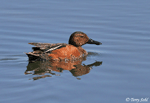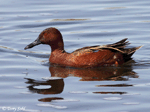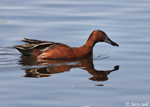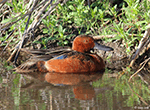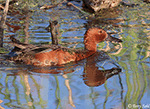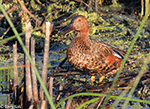| Length: 15 - 17 inches | Wingspan: 24 - 30 inches | Seasonality: Migrant/Summer |
| ID Keys: Rich cinnamon body and head on male unmistakable. Fairly long blackish spatulate bill. | ||
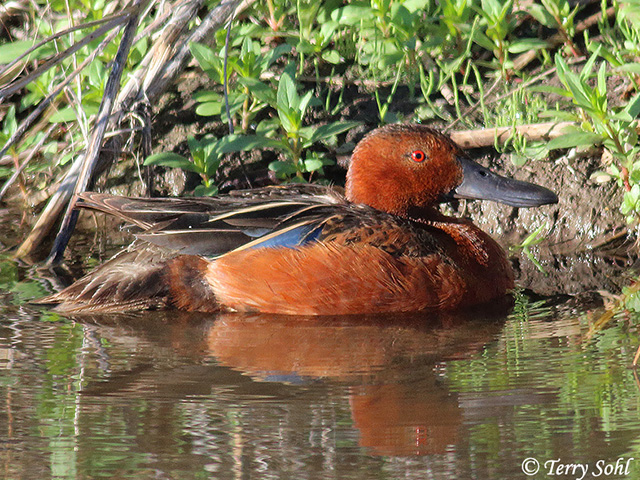 The Cinnamon Teal is an easily recognized
dabbling duck of the western United States, with the male having rich cinnamon
hues on it's body and head. They are closely related to the Blue-winged
Teal, and will sometimes hybridize with them. They have more spatulate
bills than their close cousins, however, although not as extreme as the Northern
Shoveler's bill. In South Dakota they are quite uncommon, with
sightings more common as you move westward in the state.
The Cinnamon Teal is an easily recognized
dabbling duck of the western United States, with the male having rich cinnamon
hues on it's body and head. They are closely related to the Blue-winged
Teal, and will sometimes hybridize with them. They have more spatulate
bills than their close cousins, however, although not as extreme as the Northern
Shoveler's bill. In South Dakota they are quite uncommon, with
sightings more common as you move westward in the state.
Habitat:
Prefers shallow marshes and ponds in open country during breeding season. Can be found in nearly any shallow-water aquatic habitat during migration and in winter, including salt-water habitats.
Diet:
Primarily feeds on the seeds of sedges, grasses, smartweeds, and aquatic plants. Will also feed on other plant material, insects, small crustaceans, and small mollusks.
Behavior:
A dabbling duck, feeding by partially submerging its head and straining food items from the water. They will also sometimes feed on land adjacent to water.
Nesting:
April through June. The nest of a Cinnamon Teal is placed underneath cover of dead bulrushes or other wetland vegetation, usually relatively close to water. The female selects the nesting location and builds the nest, which consists of bulrush/cattails as well as other vegetation, lined with down from her own breast. She lays 7 to 13 eggs, and she alone incubates them. The young hatch after about 23 days, leaving the nest soon after.
Song:
Weak whistling by the male, a typical quack from the female.
1Click here to hear the quacking of a female Cinnamon Teal
Migration:
Summers throughout the western United States. Winters along the California coast, locally in the extreme Southwest, Mexico, and Central America. Cinnamon Teals are unique among North American Waterfowl, as separate breeding populations also exist in South America.
Interactive eBird Map:
Click for access to an interactive eBird map of Cinnamon Teal sightings
Similar Species:
Male Cinnamon teals are distinctive, but females are similar to several other female duck species.
-
Blue-winged Teal - Females of the two species are very similar. Blue-winged Teal females are more strongly marked overall with more contrast on the head, and on the plumage on the back. Female Blue-winged Teals typically show a lighter coloring at the base of the bill, while the bill of a female Cinnamon Teal is more uniformly dark. The coloring on a Blue-winged Teal female is generally less "warm" in tone, while the female Cinnamon Teal has a warmer brown town. In reality...many of these ID characteristics are difficult to distinguish on a wild bird. Identifying females of the two species is simply easiest when looking for male birds partnered with a female.
-
Green-winged Teal - Green-winged Teal are a smaller species, and the bill looks much more petite than the bill of a Cinnamon Teal. Female Green-winged Teals also have a light tannish strip on feathering near the rump that's lacking on a female Cinnamon Teal.
Conservation Status:
Has undoubtedly declined from historic numbers due to loss of wetland habitat. Based on data from the Breeding Bird Survey and other North American data, populations have also undergone some declines in recent decades. However, they are still found over a broad geographic area and are relatively common in parts of that range. The IUCN considers the Cinnamon Teal to be a species of "Least Concern".
Further Information:
3) Audubon Guide - Cinnamon Teal
Photo Information:
June 19th, 2008 - Klamath Wildlife Refuge, California - Terry Sohl
Additional Photos:
Click on the image chips or text links below for additional, higher-resolution Cinnamon Teal photos.
Audio File Credits:
1Bernabe Lopez-Lanus. Recorded in Argentina. Original recording and information from xeno-canto.
| Click on the range map for a higher-resolution view |
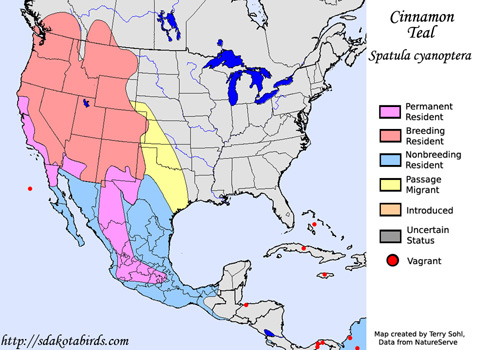 |
| South Dakota Status: Rare spring migrant and summer resident, most common in the western part of the state. |
Additional Cinnamon Teal Photos
Click for a higher-resolution version of these photos
